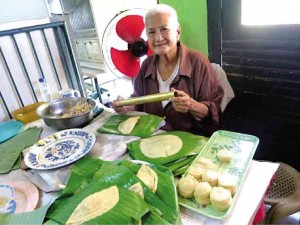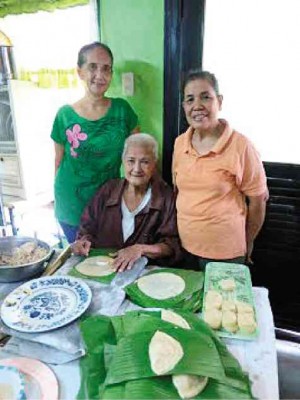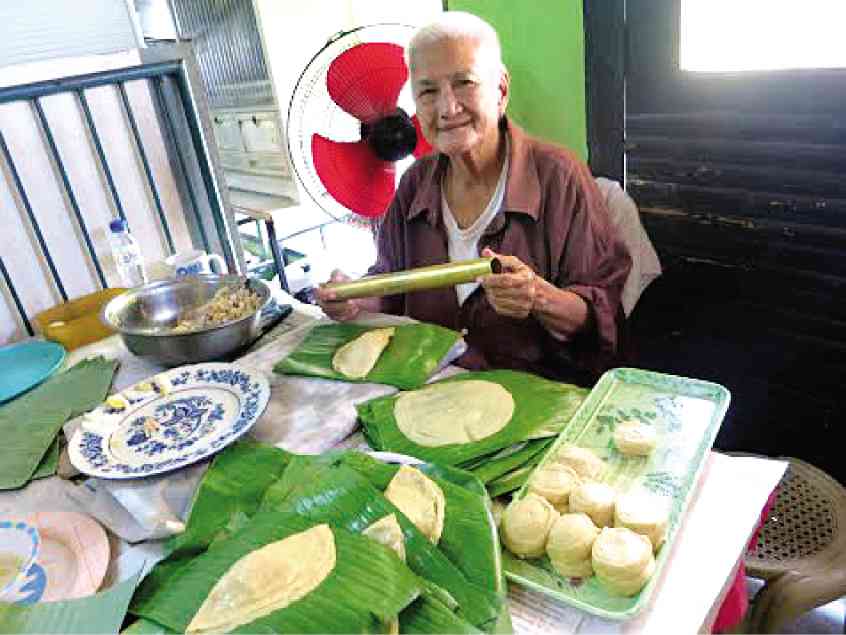
When I visited my aunt Charito Sambile, my cousin Rosen offered me empanada with a crust that resembled thin layers of rippled gold fabric. It was a work of art.
Manong Rosen urged me to take a bite. When I did, it became clear to me why he sent people all the way to Bulacan to buy boxes of it.
I wasted no time and made the trip to Malolos, Bulacan, the day after to meet the culinary icon who creates them.
Quaint store
The sign said “Mercy’s Original Empanada de Kaliskis since 1820.” It was a quaint store, with a sprinkling of tables. Leaning on the glass display was a lady packing cookies that reminded me of what my lola used to make and snack on—gorgorya and biscocho de sebo, also known as biscocho de kurbata, so named because of its necktie shape.
I also saw a table lined with banana leaves heaped with dough, a bowl of chicken filling and a stack of empanadas. In the center was Mercy Antonio, busy working.
When she saw me, she stopped, looked up and, with a smile, claimed, “Panahon pa ito ng Kastila,” pointing to her rolling pin.
She took another piece of dough, laid it on a piece of banana leaf and flattened it with her rolling pin. She then stuffed, shaped and sealed it. Over and over, dough was laboriously folded and rolled to create the layers of crisp pastry.
The empanadas were moved to a counter beside the stove where Tessie Luriaga (Mercy’s cousin) fried them, one by one, in a pan half-filled with oil. To keep the crust intact, she bathed the empanada continuously with spoons of hot oil from the frying pan, until the rippled layers of pastry turned golden. Each piece took three to four minutes to fry.
Nothing compares to eating the empanada straight off the pan. The crust was flaky, but not in a “pastry” kind of way. It was more like layer upon layer of ultra-thin lumpia wrappers. Inside was a sweetish chicken and potato filling with a slice of egg. It was a delicious treat of varying textures; crunchy at first bite, followed by mouthfuls of soft, tasty chicken filling, then ending with more crunch.
Specialty dish
It all began in 1820 when sisters Agustina Domingo de Jesus (great grandmother of Mercy) and Justina Domingo learned to cook and bake for the Spaniards. The sisters were often invited to cook for the prominent families of Malolos on special occasions.
While Agustina and Justina had a roster of specialty dishes, they became particularly famous for their empanadas, which came to be known as Empanada de Malolos.
Agustina passed the knowledge on to her daughter Trinidad de Jesus Antonio (Mercy’s grandmother), a seamstress, who later gave up sewing to sell empanadas.

Before the sisters passed away, they made Trinidad promise to hand the recipe down to members of their family who would be interested in carrying on the tradition. They also gave instructions that, should no one be interested, the recipe should end with the last person in the family who has it.
Staying true to that promise, Trinidad handed the recipe down to Lucila Antonio (Mercy’s aunt), who taught Mercy how to make it at a very young age. Mercy recalled helping her aunt at age seven.
She and cousin Tessie Luriaga are now the keepers of the family’s secret recipe. But Aling Mercy hopes to pass it on to her sister Connie Antonio Cervantes, as she is the one with children.
The popularity of their empanada has spanned generations. It has also been a favorite snack of Philippine presidents: Osmeña, Quezon, Garcia, Quirino, Marcos and Estrada.
To set their empanada apart from the rest, Aling Mercy eventually decided to call it Empanada de Kaliskis (aptly named as the crust resembles fish scales). The name was suggested by a family friend, the late food historian Mila Enriquez.
Every day at dawn you will find them making empanadas. Aling Mercy is in her late 70s; it’s good that Tessie and Connie are around to carry on their family’s treasured culinary tradition.
(Mercy’s Empanada de Kaliskis, tel. 0916-4364835. Keep the empanadas in the freezer and heat them in a toaster oven. Once heated, the empanadas will taste close to fresh.)
Tamales
On my way home to Manila from Malolos, I passed by Pandayan, Meycauayan, to buy my favorite—Aling Tasing’s Original Tamales Pandayan, made by Estrelle Padillo Vida, who learned how to make them from her mother, Aling Constancia “Tasing” Padillo.
The tamales, originally topped with just salted egg and latik, now comes in other variants—queso-latik, langka-macapuno, kasuy and chicken-pork adobo with shrimp.
I love Aling Tasing’s tamales because it’s a dessert snack that is sweet, smooth, creamy, yet spiced with hints of pepper and laced with a bit of salt.
Once you try it, your palate will know that the rice is of good quality and that pure coconut milk was used (a lot of it). From the texture and consistency, you can guess that the mixture was stirred slowly, then left over very low heat to cook, until it thickened to a paste. This was then spooned, sprinkled with toppings and wrapped in banana leaves while still warm to form little pyramids.
These tamales, like the empanadas de kaliskis, were so worth the trip!
(Aling Tasing’s Original Tamales Pandayan, tel. 0915-2346840; I enjoy them best after they have been refrigerated).
Kudos to Aling Mercy and Estrelle, true artisans who make it possible for us to take a bite back in time.
For a copy of my new class schedule, call tel. nos. 4008496, 9289296, 0908-2372346, 0917-5543700.









































